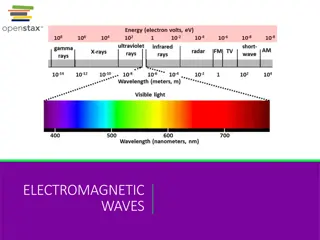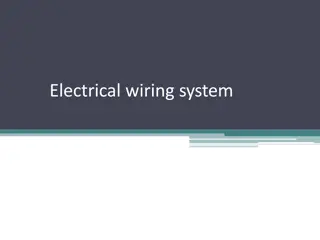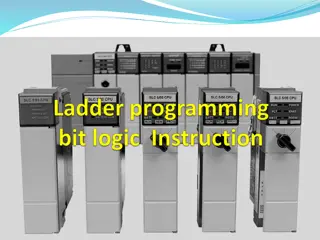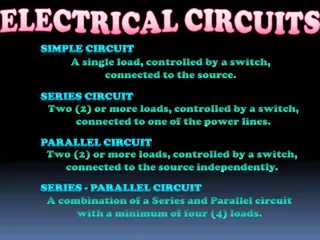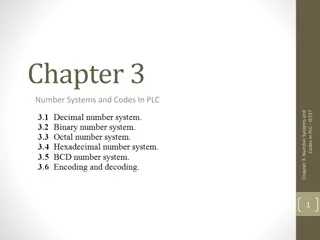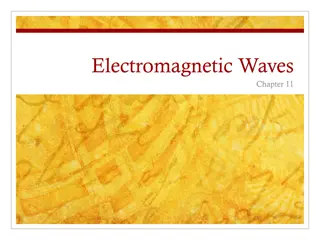Understanding Electromagnetic Control Relays in PLC Wiring Diagrams
Electromagnetic control relays play a crucial role in PLC wiring diagrams, enabling the switching of contacts using electromagnetism. This article discusses the function and operation of control relays, their representation in diagrams, and their importance in converting relay schematics to ladder logic programs.
- Electromagnetic relays
- PLC wiring diagrams
- Control relays
- Ladder logic programs
- Electrical engineering
Download Presentation

Please find below an Image/Link to download the presentation.
The content on the website is provided AS IS for your information and personal use only. It may not be sold, licensed, or shared on other websites without obtaining consent from the author. Download presentation by click this link. If you encounter any issues during the download, it is possible that the publisher has removed the file from their server.
E N D
Presentation Transcript
K.S. SCHOOL OF ENGINEERING AND MANAGEMENT, BENGALURU-560109 DEPARTMENT OF ELECTRICAL AND ELECTRONICS ENGINEERING SESSION: 2020-21(EVEN SEMESTER) PLC AND SCADA 18EE652 MODULE 2: Developing Fundamental PLC Wiring Diagrams and Ladder Logic Programs Mrs. Prathiksha Assistant Professor Dept. of EEE
Electromagnetic Control Relays The PLC s original purpose was the replacement of electromagnetic relays with a solid-state switching system that could be programmed. Although the PLC has replaced much of the relay control logic, electromagnetic relays are still used as auxiliary devices to switch I/O field devices. The programmable controller is designed to replace the physically small control relays that make logic decisions but are not designed to handle heavy current or high voltage (Figure 6-1). In addition, an understanding of electromagnetic relay operation and terminology is important for correctly converting relay schematic diagrams to ladder logic programs.
An electrical relay is a magnetic switch. It uses electromagnetism to switch contacts. A relay will usually have only one coil but may have any number of different contacts. Figure 6-2 illustrates control relay. With no current flow through the coil (deenergized), the armature is held away from the core of the coil by spring tension. When the coil is energized, it produces an electromagnetic field. Action of this field,in turn, causes the physical movement of the armature. Movement of the armature causes the contact points of the relay to open or close. The coil and contacts are insulated from each other; therefore, under normal conditions, no electric circuit will exist between them. the operation of a typical control relay. With no current flow through the coil (deenergized), the armature is held away from the core of the coil by spring tension. When the coil is energized, it produces an electromagnetic field. Action of this field, in turn, causes the physical movement of the armature. Movement of the armature causes the contact points of the relay to open or close. The coil and contacts are insulated from each other; therefore, under normal conditions, no electric circuit will exist between them.
The symbol used to represent a control relay is shown in Figure 6-3. The contacts are represented by a pair of short parallel lines and are identified with the coil by means of the letters. The letter M frequently indicates a motor starter, while CR is used for control relays. Normally open (NO) contacts are defined as those contacts that are open when no current flows through the coil but that close as soon as the coil conducts a current or is energized. Normally closed (NC) contacts are closed when the coilis de-energized and open when the coil is energized. Each contact is usually drawn as it would appear with the coil de-energized. https://www.youtube.com/watch?v=cunddFiQzrk
A typical control relay used to control two pilot lights is shown in Figure 6-4. The operation of the circuit can be summarized as follows: With the switch open, coil CR is de-energized. The circuit to the green pilot light is completed through the normally closed contact, so this light will be on. At the same time, the circuit to the red pilot light is opened through the normally open contact, so this light will be off. With the switch closed, the coil is energized. The normally open contact closes to switch the red pilot light on. At the same time, the normally closed contact opens to switch the green pilot light off.
Control relay coils and contacts have separate ratings. Coils are rated for the type of operating current (DC or AC) and normal operating voltage. Contacts are rated in terms of the maximum amount of current the contacts are capable of handling at a specified voltage level and type (AC or DC). Control relay contacts generally are not designed to carry heavy currents or high voltages. The contacts are usually rated between 5 and 10 Amp, with the most common rating for the coil voltage being 120 VAC.



